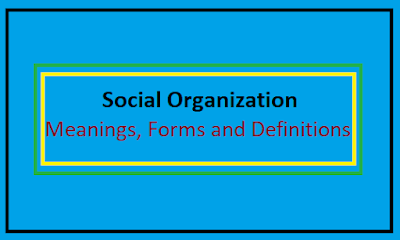The
structure of individual and group connections is referred to as social
organization. The term "organization" refers to the overall technical
arrangement of components, while "social" alludes to the fact that
social structures emerge from individual and group interactions.
Thus, one of
the key interests of sociology is to observe and evaluate human society's
actions as it occurs in its formal and ordered forms and ties. Individuals,
groups, and institutions all contribute to the larger organization that is
society. It is a vast network of social relationships that is structured like
the parts of a watch. The organizations fit in with other organizations that
influence society: the organizational process resembles a human body, a
machine, a factory, an office, a bank, and human society. Sociologists are
specifically concerned in the discovery and study of:
- The individual and groups that impact individual conduct and social foundations;
- In their organized behavior, what kinds of social relationships do they have;
- How do individuals and groups interact with one another;
- How these social ties are maintained, how they deteriorate or dissolve, and what factors influence them; and
- How individuals, whether consciously or subconsciously, organize themselves in diverse social settings.
Meanings and Forms of Social Organization
Social
organization consists of all the ways in which men live and work together,
especially all of the participants of societies programmed, ordered and
coordinated relationships. Social organizations arrange and communicate group
actions at various levels. They organize and crystallize various individual and
collective desires.
Definitions of Social Organization
A social
organization, according to Duncan Mitchell, is "the interdependence of
components, which is fundamental property of all long lasting collective
organizations such as groups or communities and societies."
Organizations,
according to Ogburn & Nimkoff, are "groups of people who work together
to accomplish a goal."
According to
Nimkoff & Ogburn, "An organization is an articulation of various parts
performing different functions, an active group device for doing
something."
Duncan
Mitchell says that, "Social organization means the interdependence of
parts of all persistent collective entities, groups, communities and societies
that are essential characteristics."
According to
Broom and Selznick, an organization implies specialized plan of parts. Social
organization implies social relationship among gatherings. People and
gatherings interrelated together make social organization. It is the
consequence of social association among individuals. It is the organization of
social relationship where people and gatherings partake. Every one of the
social foundations are social organizations. Affiliations, clubs and any
remaining proper gatherings are organizations. Social frameworks are
additionally founded on' social organizations. In a coordinated body; its
individuals get into each other based on jobs and status. The collaboration
among the individuals sets them into organizations. The method of such
collaboration is called social organization.
Relationship of Social Organization, Status and Role
According to
their social roles, called status, the participants in a social organization
conduct their tasks. The tasks conducted in an organization are considered
members' positions, and even people conduct their roles in accordance with
their rank. Therefore, the basis of social involvement in an association is
status and position. If official, an organized body has its duties and rank
allocated to its representatives and office bearers. Like office-bearers. The
President, Vice-President, and Secretary responsibilities and ranks within an
organization are defined by the rules and regulations of that entity. All trade
unions and professional associations affiliated with the United Nations
Organization (UNO) are social organizations in which participants' roles and
status are specified. There are two broad categories of social organizations,
namely, those that arise out of kinship and those that result from members'
free and voluntary associations.
Relationship of Social Organization and Interaction
The product
of social contact is social organization. Interaction between persons, between
individuals, between organizations, between classes, between members of a
family creates a social organization. Organization implies an association with
participants or elements. By contact between them, the members of a family
become an organized community. Likewise, the parts of a factory have reciprocal
relation with each other. The components of one item travel from one segment to
another section before it is finished and then it is translated into a whole by
arranging its components. These factory parts communicate with each other and
create components of a system, and then these components, organized together,
make a machine as a whole complex. All is related to the relationship between
sectors, groups and individuals. The outcome of social organization is this
development.
Relationship of Social Organization and Social System
The social
structure is an ongoing unit that is generated by the interdependence of its
components. A structure assigns its components to various roles. Such modules
have reciprocal interaction, assisting one another. With the support of each
other, these distinct tasks done by separate parts make the entire structure
and this interrelation between its parts is called organization. It says the
functioning of the sections is a scheme. An individual still holds a socialstructure.
SocialInteraction => Social Organization => Social System
All the
three definitions above are interrelated. A family, by contact with its
members, is an integrated structure. There is a greater degree of activity in a
system than outside the system. By social contact, the members of a family
establish an organized community. Although working as a whole, this community
is a social system. On the basis of their rank and function, the members
communicate. In the household, this fixes them in their respective positions.
The family is an organized social entity today. If such an integrated family
exists, it is a social structure in a certain situation.
Categories
of Social Organizations - Types of Social Organizations
Keywords: Sociology, Introduction to sociology, Book of sociology, Culture, Institutions, Organizations, Types of Sociology, What is Sociology, Society, Human Behaviors, PDF Book Sociology, Scope of Sociology, Types of Sociology, Self.

